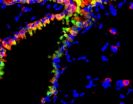(Press-News.org) PHILADELPHIA - When poet Walt Whitman wrote that we "contain multitudes," he was speaking metaphorically, but he was correct in the literal sense. Every human being carries over 100 trillion individual bacterial cells within the intestine -- ten times more cells than comprise the body itself.
Now, David Artis, PhD, associate professor of Microbiology, along with postdoctoral fellow David Hill, PhD, from the Perelman School of Medicine at the University of Pennsylvania, and collaborators from The Children's Hospital of Philadelphia and institutions in Japan and Germany, have found that these commensal bacteria might play an important role in influencing and controlling allergic inflammation. The commensal relationship that develops between humans and internal bacteria is one in which both humans and bacteria derive benefits.
The study -- appearing this week in Nature Medicine -- suggests that therapeutic targeting of immune cell responses to resident gut bacteria may be beneficial in treating allergic diseases.
The researchers build on previous work demonstrating that selective manipulation of the commensal bacterial population could affect the immune system. "Studies in human patients suggest that changes in commensal populations or exposure to broad spectrum antibiotics can predispose patients to the development of systemic allergic diseases," Hill explains. "In addition, previous studies in animal models have shown that commensal bacteria can influence local immune cells in the intestine. However, the cellular and molecular mechanisms by which commensal bacteria influence the host immune system, in particular the branches of the host immune system that regulate allergic inflammation, are not well understood."
Artis and his colleagues focused on the role of basophils, a type of white blood cell, in causing allergic inflammation, and the relationship between basophil responses and allergic disease.
The investigators administered broad-spectrum oral antibiotics to deplete certain types of bacteria in mice and to subsequently examine the affects on levels of circulating basophils in the blood. Using an animal-based model of allergic inflammation in the lung that shares characteristics with asthma in humans, they found that antibiotic treatment resulted in significantly elevated basophil responses and a marked increase in the amount of basophil-mediated allergic airway inflammation. Elevated serum levels of IgE, an important mediator in allergic disease, were also observed.
After the antibiotic-treated mice were exposed to house dust mite allergen (HDM), a human allergen and a model of allergic airway disease in mice, they showed higher basophil responses in the blood and lymph nodes as well as a heightened allergic response with increased inflammation in the lungs.
Germ-free mice, which are reared in a sterile environment and thus lack all live commensal bacteria, also showed similar responses to those observed in antibiotic-treated mice when exposed to HDM. This finding indicates that commensal bacteria-derived signals are responsible for maintaining normal basophil numbers in the steady-state.
Artis and his colleagues also found that serum concentrations of IgE and circulating basophil numbers were limited by B cell-intrinsic expression of myeloid differentiation factor 88 (MyD88), a protein known to play a role in the recognition of bacteria-derived factors. Signals derived from the commensal bacteria were found to act via IgE to control the number of circulating basophils by limiting the proliferation of basophil precursor cells in the bone marrow.
All of these findings indicate important new processes by which resident commensal bacterial populations influence and control basophil responses and thus influence the response to allergens in our environment.
"The identification of a mechanistic connection between commensal bacteria, basophils, and allergic disease illuminates several new avenues that could be targeted by future therapeutics to block or inhibit the development of allergic disease," Artis notes. Further study and identification of these commensal pathways could also have implications for other chronic diseases related to immune system functioning.
Artis and his colleagues hope to further understand this intricate interplay between the immune system and commensal bacteria. "It may be beneficial to identify the specific commensals and commensal-derived signals that regulate circulating basophil populations as this could lead to the development of new probiotic or other commensal-derived therapies," he says. The work makes clear that the bacterial multitudes within our bodies may have a function and a value never before appreciated.
INFORMATION:
This work was funded by grants from the National Institute of Allergy and Infectious Disease, the National Cancer Institute, the Burroughs Wellcome Fund, the Penn Genome Frontiers Institute, and the Penn Center for the Molecular Studies in Digestive and Liver Diseases.
Penn Medicine is one of the world's leading academic medical centers, dedicated to the related missions of medical education, biomedical research, and excellence in patient care. Penn Medicine consists of the Raymond and Ruth Perelman School of Medicine at the University of Pennsylvania (founded in 1765 as the nation's first medical school) and the University of Pennsylvania Health System, which together form a $4.3 billion enterprise.
The Perelman School of Medicine is currently ranked #2 in U.S. News & World Report's survey of research-oriented medical schools. The School is consistently among the nation's top recipients of funding from the National Institutes of Health, with $479.3 million awarded in the 2011 fiscal year.
The University of Pennsylvania Health System's patient care facilities include: The Hospital of the University of Pennsylvania -- recognized as one of the nation's top 10 hospitals by U.S. News & World Report; Penn Presbyterian Medical Center; and Pennsylvania Hospital — the nation's first hospital, founded in 1751. Penn Medicine also includes additional patient care facilities and services throughout the Philadelphia region.
Penn Medicine is committed to improving lives and health through a variety of community-based programs and activities. In fiscal year 2011, Penn Medicine provided $854 million to benefit our community.
Inner weapons against allergies: Gut bacteria control allergic diseases
2012-03-26
ELSE PRESS RELEASES FROM THIS DATE:
PuckProspect.com Hockey Scouting and Hockey Recruiting Website Not in the Daily News Yet
2012-03-26
PuckProspect.com (www.puckprospect.com) introduced it's hockey scouting and hockey recruiting service with not much fanfare. It did not make msnbc news or even the daily news. It did however serve notice that another online player is bidding for recognition in the relatively small world of internet hockey recruiting and hockey scouting services.
PuckProsect.com' s hockey scouting and hockey recruiting service is not for everyone! It's not for football players, baseball players, basketball players... you get the idea. It's for hockey people! Unlike other scouting websites ...
Intervention results in increased use of evidence-based medications for patients with ACS
2012-03-26
Among patients with acute coronary syndromes (such as heart attack or unstable angina) treated at public hospitals in Brazil, implementation of a multifaceted intervention that included educational materials, checklists and reminders resulted in improvement in the use of evidence-based medicines during the first 24 hours of hospitalization, according to a study appearing in JAMA. The study is being published early online to coincide with its presentation at the American College of Cardiology's annual scientific sessions.
Cardiovascular diseases, especially acute coronary ...
ALTAIR Releases a Premium Limited Edition Collectible Timepiece for Race Fans and Watch Collectors
2012-03-26
It's time for a new collectible in motorsports! Die cast cars have been a mainstay in the motorsports collectible market for years and until now there hasn't been anything new on the horizon. The newest collectible for motorsports fans and watch collectors is the ALTAIR ICON 3. The ALTAIR ICON 3 timepiece contains a piece of an actual raced tire off the famous #3 Chevrolet during one of its historic runs. ALTAIR is privileged to be granted one of the last remaining tires authenticated by Richard Childress and Richard Childress Racing (RCR) as "race used" by the ...
Infusion of drug into the coronary artery may help reduce size of heart damage after heart attack
2012-03-26
Administration of a bolus dose of the anticoagulant drug abciximab into the coronary artery involved in causing a certain type of heart attack among patients who were undergoing a percutaneous coronary intervention and also receiving another anticoagulant resulted in reduction in the size of damage to the heart muscle at 30 days, while a procedure that involved use of a catheter to remove the blood clot blocking that coronary artery did not produce these results, according to a study appearing in JAMA. The study is being published early online to coincide with its presentation ...
The long, err, short of it
2012-03-26
BOSTON, MA—No one really wants the short end of the stick, in this case the short end of a chromosome. Telomeres, which are DNA-protein complexes at the ends of chromosomes, can be thought of as protein "caps" that protect chromosomes from deteriorating and fusing with neighboring chromosomes.
It is typical for telomeres to shorten as cells divide and chromosomes replicate over time. Now a new study from Brigham and Women's Hospital (BWH) suggest a strong link between telomere shortening and poor cardiovascular outcomes in patients with acute coronary syndrome.
The ...
Researchers discover first-ever link between tiny genetic structures, imminent heart attack risk
2012-03-26
SALT LAKE CITY — Researchers at the Intermountain Medical Center Heart Institute have, for the first time ever, made a connection between tiny genetic molecules called microRNAs and the imminent threat of a heart attack, according to a new study.
The findings are an important first step toward developing a method for predicting heart attacks in people who show no outward signs, but may be at great risk of having a heart attack. The research group will present study results today (March 25) at the American College of Cardiology's 61st Annual Scientific Session in Chicago.
"About ...
Diabetes associated with higher risk of cardiovascular problems in men
2012-03-26
BOSTON, MA—According to a new study by researchers at Brigham and Women's Hospital (BWH), men with type 2 diabetes treated with insulin without a history of cardiovascular disease (CVD) were at higher risk for major cardiovascular events (e.g., death, heart attack, stroke) compared with men who had a history of CVD.
The study is being presented at the American College of Cardiology 2012 Annual Scientific Session, March 24 to 26 in Chicago.
Using data from the global REACH Registry, researchers evaluated the magnitude of risk of diabetes mellitus on cardiovascular ...
Large-scale, community-wide preventive initiative dramatically impacts CV risk profile
2012-03-26
CHICAGO -- A population-wide community and clinical prevention program involving 10,000 adults meaningfully reduced the cardiovascular (CV) risk profile among a substantial portion of the population as indicated by those participating in screenings. Findings also indicate the level of improvements differ by gender for specific cardiovascular risk factors. The results will be presented March 25 at the 61st annual American College of Cardiology (ACC) scientific session.
Hearts Beat Back: The Heart of New Ulm Project (HONU) is a demonstration project aimed at reducing heart ...
Some 90-year-old heart attack patients have 'excellent' outcomes with coronary stenting
2012-03-26
CHICAGO—Selected patients 90 years and older who experience an acute heart attack, or ST-elevation myocardial infarction (STEMI), have reasonable outcomes with coronary stenting, and should be considered for reperfusion therapy, based on a scientific poster being presented at the 61st annual American College of Cardiology (ACC) scientific session.
Current STEMI guidelines do not specifically address age-related reperfusion decisions, even number though the number of people over 90 years old in the U.S. is expected to quadruple by 2050.
"Cardiologists are a little ...
New Dallas Marriott City Center Introduces Centric
2012-03-26
As the Dallas Arts District continues to grow and reshape northern downtown Dallas, the new Dallas Marriott City Center introduces Centric, the latest addition to the restaurant scene - a hotspot within walking distance of the AT&T Performing Arts Center, the Meyerson Symphony Center, the Dallas Museum of Art and more.
Located at 650 N. Pearl St. at the Plaza of the Americas, the upscale restaurant features a Texas eclectic menu by Executive Chef Yoni Heredia, with fresh ingredients sourced from local producers including Dallas' Mozzarella Company, Jimmy's Food Store ...


